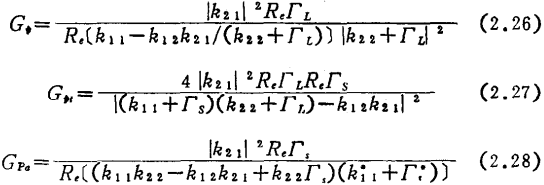Electronic Technology Forum
Describe the detailed analysis of MOS tube high-frequency gain and stability function analysis
Here is a description of the function derived from the four-terminal parameter as the standard for high-frequency amplification characteristics.
As a function of high-frequency amplification characteristics, we hope that it has nothing to do with the type of four-terminal parameter. Here are the results of Rollet's research on invariants in the transformation process between immittance parameters such as y and z or mixed parameters such as h and g 8). The following uses represents a general four-terminal parameter, using
represents a general four-terminal parameter, using To represent the actual part, use
To represent the actual part, use represents its imaginary part.
represents its imaginary part.
Study stability first. At ρ11, ρ22 1 under the conditions of, when the device is unconditionally stable (no matter what the extreme conditions of the input and output do not cause oscillation), the stability coefficient of Basil is required
1 under the conditions of, when the device is unconditionally stable (no matter what the extreme conditions of the input and output do not cause oscillation), the stability coefficient of Basil is required

(This value can be a value between +∞ and -1) greater than 1. In addition,
 Sometimes it is possible to oscillate depending on the terminal conditions, which is equivalent to conditional stability (potential instability). MOS tube high frequency gain function. When the terminal immittance
Sometimes it is possible to oscillate depending on the terminal conditions, which is equivalent to conditional stability (potential instability). MOS tube high frequency gain function. When the terminal immittance  is added to the input and output,The total stability factor of the entire system is
is added to the input and output,The total stability factor of the entire system is

where .K is a useful quantity that represents the stability of the tuning amplifier. The stability factor is used by Linvill 9)
.K is a useful quantity that represents the stability of the tuning amplifier. The stability factor is used by Linvill 9) and Stern (10) used s (see page 73), etc., and S is not an invariant in parameter substitution.
and Stern (10) used s (see page 73), etc., and S is not an invariant in parameter substitution.
There are three definitions for the power gain of the amplifying system:
1) Power gain

Where Pi is the input power of the amplifier, and Po is the output power of the amplifier (to the load).
2) Transducer gain

where it is the power taken by the signal source.
it is the power taken by the signal source.
3) Available power gain (available gain)

where is the power taken from the output of the amplifier.
is the power taken from the output of the amplifier.
From the definition, the immittance value with the signal source,
the immittance value with the signal source, It has nothing to do with the immittance value of the load. The three gain expression methods have their own characteristics. For example, the performance of the amplifier connected to the constant signal source (its effective power is also constant, such as antenna, etc.) is
It has nothing to do with the immittance value of the load. The three gain expression methods have their own characteristics. For example, the performance of the amplifier connected to the constant signal source (its effective power is also constant, such as antenna, etc.) is ; MOS tube high frequency gain function. The amplifier matches the load, and the output power Po is
; MOS tube high frequency gain function. The amplifier matches the load, and the output power Po is time
time  for
for  .by
.by the magnitude relationship of can be obtained by the following inequality:
the magnitude relationship of can be obtained by the following inequality:

The relationship between these power gains and the four-terminal parameters is as follows.

where respectively, the signal source and load immittance. These gains are also invariant after parameter replacement.
respectively, the signal source and load immittance. These gains are also invariant after parameter replacement.
 time, change
time, change make the input and output conjugate matching at the same time, at this time
make the input and output conjugate matching at the same time, at this time the three are the same, take the maximum value and call it the maximum available gain
the three are the same, take the maximum value and call it the maximum available gain . Expressed by the following formula:
. Expressed by the following formula:

This is a value determined by the device itself, so it is also an invariant ●)
 it can also be written as a formula containing image.png:
it can also be written as a formula containing image.png:

▏Y21/Y12▕ is also invariant. When adding a lossy terminal to the input and output of the device, K→1. At this time, the entire four-terminal network enters an area of unconditional stability and conditional stability.
When adding a lossy terminal to the input and output of the device, K→1. At this time, the entire four-terminal network enters an area of unconditional stability and conditional stability. it becomes ▏Y21/Y12▕. MOS tube high frequency gain function. In this sense, it is called the maximum stable gain (MSG).
it becomes ▏Y21/Y12▕. MOS tube high frequency gain function. In this sense, it is called the maximum stable gain (MSG).

Based on the above reasons, it can be known that the other parameters indicate that the characteristics of the device itself are more appropriate.
the other parameters indicate that the characteristics of the device itself are more appropriate.
Figure 2.23 is the MAG, MSG and MAG of a typical field effect transistor calculated according to the y parameter the relationship with frequency.It can be seen from the figure that the cascaded gate MOS field effect transistor has good stability.
the relationship with frequency.It can be seen from the figure that the cascaded gate MOS field effect transistor has good stability.
Contact: Mr. Zou
Contact number: 0755-83888366-8022
Mobile phone: 18123972950
QQ: 2880195519
Contact Address: 5C1, Block CD, Tianji Building, Tianan Digital City, Chegongmiao, Futian District, Shenzhen
Please search WeChat official account: "KIA Semiconductor" or scan the following picture to "Follow" official WeChat official account
Please "follow" the official WeChat account: provide MOS tube technical assistance




